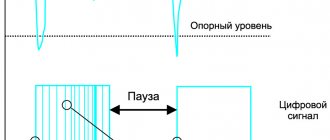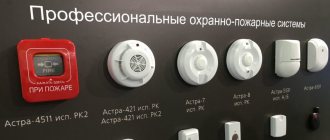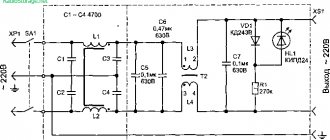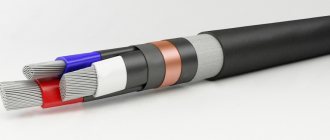UPS stands for “uninterruptible power supply.” The abbreviation in English is UPS (Uninterruptible Power Supply), so the names UPS, UPS, and upsnik are also common.
The main function of an uninterruptible power supply is to ensure the supply of electricity to the equipment connected to it during outages in the main network. But, depending on the type of equipment, the parameters of such autonomous power supply may be required to be radically different. Accordingly, the UPS market offers different types of devices, which differ in a lot of parameters:
- principle of operation: offline, linear-interactive, online;
- type of automatic voltage regulation;
- quality of filtering network interference;
- capacity (the number of ampere-hours, or in other words - how long will the battery life last);
- time to switch to batteries during a power outage;
- possibility of connecting additional external batteries;
- various additional functions (filtering sockets, sockets for telephone and network cables, LCD display, synchronization with a PC), etc.
How to choose a UPS with such a variety of models? How to understand how they differ? In this article we will look at the main types of uninterruptible power supplies, their differences, and what additional functions manufacturers equip UPS with. In the next one - how to choose a UPS depending on the features of your equipment, how to calculate its required power, etc.
- Three main types of UPS:
- Off-line (Back-UPS, backup, Standby) uninterruptible power supply.
- Line-interactive UPS.
- Double conversion UPS (on-line).
- Synchronization with PC.
- Cold start.
- Schuko sockets.
- Sockets for filtering interference, telephone line, twisted pair.
Backup UPS (off-line, standby, back ups)
Operating principle
If the external network is operating in normal mode, the UPS powers the load directly from the input and operates similarly to a surge protector. In the event of a voltage deviation from acceptable limits or when it is completely turned off, the backup UPS automatically switches the load to the batteries (power in this mode is provided through an inverter that converts direct current into alternating current). Switching back is also automatic and occurs after the mains voltage returns to normal.
Advantages and disadvantages
Currently, the only significant advantages of off-line UPS include low cost.
The disadvantages of backup UPSs are:
- a break in the power supply that occurs when the load is switched to the battery and back (at least 5 ms);
- lack of voltage stabilization and frequency correction when operating from the mains;
- transition to AB even with small network surges, which, in the conditions of the domestic power system, leads to rapid wear of batteries;
- non-sinusoidal output voltage when operating in stand-alone mode (approximated sinusoid, sometimes called “quasi-sinusoid”);
- low level of protection against high-voltage surges and electromagnetic interference.
Application
The above disadvantages narrow the scope of application of backup UPSs. These devices are suitable for operation only in conditions of a stable electrical network and only with equipment capable of operating at low quality supply voltage. Off-line UPS should not be used to protect modern microprocessor technology or devices containing asynchronous and inverter motors - pumps, refrigerators, washing machines, air conditioners, heating boilers, etc.
An uninterruptible power supply (UPS), or Uninterruptible Power Supply (UPS), is a device whose main function is to supply uninterrupted power.
The operating principle of all UPSs is based on maintaining the load from the batteries during a power outage in the 220V (380V) network.
There are many types of UPS for different purposes and tasks, with additional options and capabilities, but there are only three main types of UPS:
- Backup (Back UPS, Standby, offline)
- Line interactive , smart UPS
- Double conversion (online UPS, double conversion UPS, real time UPS)
Also, UPS may differ:
- Output waveform
- Power
- Switching time to batteries
- Number of phases (1 phase or 3 phases) at the input and output
- Availability of built-in or external batteries (battery packs)
- For UPSs with built-in batteries, the ability to connect additional external battery packs
- Possibility of synchronization with a computer (USB, RS-232 interfaces)
- Support for network cards for remote management (SNMP, ModBUS, dry contacts)
- Availability of electronic or mechanical bypass
- LCD screen
- Output sockets: computer C14 or euro sockets (schuco)
- Working in parallel
- Modular structure
- Availability of cold start
- Operating voltage range without switching to batteries
- Floor-standing, rack-mount, wall-mounted design
And a lot of other parameters: the presence of lightning protection, telephone line protection, twisted pair cable, insulating transformer, size, color, case material, price, etc.
How to figure it out? We will help.
So, there are three main types of UPS.
Type 1 - P backup (Back UPS, Standby, offline)
The principle of operation of a standby UPS (literally in standby mode) is simple: when there is voltage in the network, through a system of filters (or without them), it supplies “socket” current directly to the outputs. At the same time, it maintains the battery charge.
When the voltage fails or goes beyond the “normal” range, it switches to battery operation.
Switching occurs using a relay, and the relay response time is 3-15 milliseconds. In this case, signal distortion occurs, accompanied by a short-term voltage surge. For some devices this switching time is unacceptable.
Direct current from the battery is converted into alternating current by an inverter, usually a simple one. Therefore, instead of a sinusoidal signal, a similar sine wave, called a meander, is supplied to the output of the UPS when operating on batteries. At best, the sinusoid is approximated or modified, i.e. not entirely square, but consisting of smaller squares. The smaller the square, the closer to the ideal sine wave.
Pros of offline UPS:
- Low price
- Quiet operation when working from the network
- Simplicity
- High efficiency
- Minimal care
Minuses:
- Switching time to battery
- Modified sine wave
- Poor protection against interference and noise on the network
- No frequency or voltage adjustment
Most models have low power (up to 1500VA) and short battery life (up to 5-8 minutes at full load) and are designed to power computers and workstations, as well as low-power devices with switching power supplies, for which the waveform when operating from batteries are not critical.
It is not advisable to use Back UPS devices to protect equipment with transformer power supplies and electric motors. Long-term operation of such devices from a stepped sine wave leads to overheating of the coils.
Type 2: Line interactive , smart UPS
The main difference between the line-interactive topology and the back UPS is considered to be the presence of an AVR (automatic voltage regulator), or, in other words, a simple step stabilizer. The principle of its operation is simple: AVR has several fixed adjustment steps (for example, +-30V), as a rule, no more than two steps for lowering and three for increasing voltage.
Example: When the network voltage drops to a certain value (for example, 175V), the AVR turns on one +30V stage. Those. at the UPS output the voltage becomes 205V. And vice versa, with an increased voltage of 260V, the -30V regulation is turned on and the UPS output voltage is 230V. Sufficient for most devices.
When the mains voltage goes beyond the operating limits of the AVR and in the event of a complete loss of the mains, the UPS switches to batteries through a relay, just like with backup UPSs.
If 10-15 years ago it was possible to clearly distinguish between offline and linear-interactive power supplies, now the line between these types of UPS is gradually blurring. New Back UPSs acquire the simplest AVRs and are now proudly called linear-interactive, while producing a coarse stepped sine wave and turning off by a timer (and not by the battery) to protect against overheating.
More advanced models have an inverter with a sinusoidal output voltage, microprocessor control (for such models the word “SMART” is usually added to the name) by analogy with the SmartUPS line of the world's largest UPS manufacturer APC (American Power Conversion). Smart phones already have advanced functionality of settings and capabilities, such as changing parameters for switching to batteries, support for network cards, emergency shutdown buttons (EPO), replacing batteries without disconnecting the load, and even turning off the load by priority during a long absence of voltage in the network.
Example : the most advanced UPSs can turn off sockets separately. After a minute (can be adjusted) of no voltage, the iron and kettle will be turned off, after two minutes the main lighting and, lastly, video surveillance, emergency lighting and the main server). Well, or, if desired, in reverse order.
Pros of line-interactive UPS:
- Sine wave output for older models
- Larger power range (up to 5kVA)
- Voltage regulation without switching to batteries
- Silent operation from the network
- Low energy consumption for own needs
- Minimal care
- High power factor VA/W up to 0.9 for older models
Flaws:
- Switching time to batteries
- Inability to completely filter voltage from low-frequency interference and noise
- Lack of smooth voltage stabilization
- Limited power (up to 5000VA)
It is used in all areas where high-quality power supply is necessary: from computers, cash registers, to powerful servers, building management systems.
Type 3: Double conversion UPS (online UPS, double conversion UPS, real time UPS)
This type of UPS is fundamentally different from the two previous types. If line-interactive and standby UPSs under normal conditions simply pass network electricity through themselves like a wire, and the inverter only works when running on batteries, then the inverter works constantly .
The alternating current (220V, 380V) at the input is converted by the rectifier into direct current (DC), and then the inverter converts the direct current into alternating current and supplies it to the output. That is, the incoming and outgoing current are in no way connected with each other . All the advantages of this type of UPS follow from this: no interference, surges, or signal distortions are reflected in the load. Whatever problems there are with electricity in the network (high or low voltage, distortion of the signal shape, change in Hz frequency, noise, bursts), the output is a stable, even sine wave. The UPS batteries are also always connected to the operating circuit and when the voltage in the network and, accordingly, on the rectifier fails, they supply direct current to the inverter. Due to the potential difference, there is no switching time to the battery, it is zero.
Online uninterruptible power supplies have constant phasing (so-called end-to-end neutral) at the output. All these advantages allow you to use online UPS for protection, as a filter and stabilizer together with highly sensitive and demanding equipment in almost all areas of activity (gas boilers, medical and measuring equipment, hi-fi, hi-end equipment). Such UPSs are recommended for installation after gasoline, diesel or gas generators. While the generator starts up and reaches the specified power, the voltage is maintained by the UPS. After turning on the generator, the UPS charges the battery and corrects the not always ideal voltage from the generator.
Example: in Hi- Fi and Hi- End equipment, no matter how clean and even the voltage in the network, the speakers produce a slight hiss. When connecting equipment via online UPS, the hissing disappears.
Due to the constant operation of the rectifier and inverter, a double conversion UPS requires constant cooling. Therefore, such devices are necessarily equipped with fans that operate in all operating modes (from mains, from batteries). Accordingly, there is always noise, which limits the comfortable use of such UPSs in residential areas. Also, when fans constantly operate in a dusty room, dust gets clogged inside the case, which prevents heat dissipation. Regular cleaning of the device and monitoring the serviceability of fans with their timely replacement is required. Neglect of maintenance leads to overheating of constantly operating components and accelerated failure of both the inverter and batteries (batteries do not tolerate operation at elevated temperatures).
Double conversion technology, unlike line-interactive and redundant UPSs, has no power limitation. Nowadays, UPSs with capacities ranging from 700VA to parallel systems of several megawatts are produced.
Advantages of online UPS:
- No switching time to batteries
- Protection of the load from any network problems (frequency, noise, voltage surges and sags)
- Through neutral
- High power factor VA/W up to 1 (i.e. 1000VA equals 1000W)
- Wide range of mains operation (from 100 to 350 V)
Flaws:
- High price
- Noisy in all operating modes
- The need for frequent and regular monitoring and maintenance
- Low efficiency (even in idle mode significant energy consumption)
Application: power up to 5 kVA for devices that are demanding on switching time to batteries, frequency, sinusoid shape, interference, voltage deviations, through-neutral. Above 5kVA for all devices that require uninterrupted operation, because... At high power there are no alternatives to online UPS.
Line-interactive UPS
Operating principle
Similar to the previous option, except that the device circuit is supplemented with an input voltage regulator. UPS of this type are divided into devices with an approximate sinusoid and a completely sinusoidal output voltage.
Advantages and disadvantages
Advantages of line-interactive UPSs over backup ones:
- the ability to neutralize network fluctuations (but not the maximum amplitude!) without using AB;
- reduced switching time to offline mode (due to synchronization of the inverter and the input network).
The disadvantages of line-interactive UPSs are:
- stepwise voltage regulation, leading to severe distortion of the output signal;
- interruption in the power supply to the load when switching to batteries (switching duration is shorter than that of a backup UPS, but non-zero!);
- lack of correction of the shape of the input voltage and input frequency when operating from the mains, incomplete filtering of network noise;
- Most models do not form an ideal sine wave of the output voltage in stand-alone mode.
Application
Not all electrical equipment will work successfully with line-interactive UPSs. The quality of their output voltage may simply not meet the stringent requirements of modern electricity consumers in both the domestic and industrial sectors. In particular, a line-interactive UPS is not the best option for a heating system boiler, IT equipment, and especially for interference-sensitive scientific, laboratory and medical equipment.
In addition, line-interactive UPSs do not provide power that is completely independent of the state of the external power system, which maintains the risk of damage to the load as a result of, for example, a sudden mains interruption.
comparison table
Place in the ranking/Name Expert rating Price range, rub.
| The best line-interactive UPSs | ||
| Powercom RAPTOR RPT-600A EURO | 80 out of 100 | From 2,489 to 4,546 * |
| IPPON Back Basic 850S Euro | 80 out of 100 | From 3,935 to 4,926 * |
| CROWN MICRO CMU-SP1200EURO USB | 86 out of 100 | From 6,700 to 7,230 * |
| SVEN RT-500 | 88 out of 100 | From 7,223 to 8,489 * |
| Energy Guarantor 500 | 88 out of 100 | From 9,960 to 24,276 * |
| Hiden Control HPS20-0612 | 90 out of 100 | From 11,900 to 13,500 * |
| The best backup UPSs | ||
| Powercom SPIDER SPD-1000N | 88 out of 100 | From 5,142 to 11,645 * |
| IPPON Back Verso 800 New | 90 out of 100 | From 6,084 to 9,975 * |
| EATON 3S700DIN | 90 out of 100 | From 9,040 to 19,074 * |
| APC by Schneider Electric Back-UPS BE700G-RS | 96 out of 100 | From 10 638 * |
| Best Double Conversion UPS | ||
| IPPON Innova G2 1000 | 88 out of 100 | From 18,870 to 22,106 * |
| P-Com Pro 2H | 88 out of 100 | From 30,500 to 89,481 * |
| Powerman Online 3000 | 90 out of 100 | From 32,380 to 39,100 * |
| Vertiv GXT5-1500IRT2UXLE | 92 out of 100 | From 60,710 to 71,702 * |
| EATON 9SX5KiRT | 96 out of 100 | From 204,839 to 269,774 * |
*prices are valid for January 2022
When selecting models, we considered not only the technical characteristics of the devices, but also considered reviews from those users who had already purchased a specific UPS. Therefore, the review turned out to be as complete as possible.
Online UPS (on-line, double conversion UPS)
Operating principle
The device performs double conversion of the voltage coming from the network. First from variable to constant, and then back - from constant to variable. In the power circuit of an on-line UPS, the batteries occupy an intermediate position between the continuously operating rectifier and inverter (the batteries are connected to the output of the first and the input of the second). This scheme allows you to avoid delays when switching to offline mode, since the inverter is constantly connected to the battery and no additional switching is required in case of problems with the external power supply network.
Advantages and disadvantages
Advantages of online UPS:
- instant switching to battery power (without interruption of power supply to the load);
- sinusoidal shape and the most accurate value of the output voltage (provided both when operating from the mains and from batteries);
- wide amplitude of network fluctuations, neutralized without switching to offline mode;
- maximum load protection (double energy conversion dampens all negative input influences and guarantees complete independence of the UPS output characteristics from the state of the external power supply);
- no influence of connected equipment on the main power grid.
Disadvantages of online UPS:
- higher cost compared to devices of other categories;
- low efficiency (80-90%) of some outdated devices (it is worth noting that modern control algorithms for double energy conversion, used by leading manufacturers of on-line UPS, can significantly increase efficiency and bring it in a number of operating modes to 99%).
Offline UPS
Offline UPS (off-line, Standby, back ups or backup) is a type of uninterruptible power supply, the principle of which is to switch equipment to a backup battery (which is part of the UPS) when a power failure occurs.
| Pros: | Minuses: |
| simplicity economical compactness | lack of input voltage stabilization when operating from the mains; higher battery wear (compared to other types) |
Application: for short-term protection of home PCs and office computer equipment.
UPS diagram with offline technology











